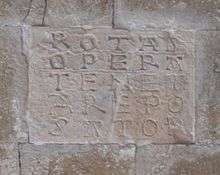Capestrano
| Capestrano | |
|---|---|
| Comune | |
| Comune di Capestrano | |
 | |
 Capestrano Location of Capestrano in Italy | |
| Coordinates: 42°16′10″N 13°46′0″E / 42.26944°N 13.76667°ECoordinates: 42°16′10″N 13°46′0″E / 42.26944°N 13.76667°E | |
| Country | Italy |
| Region | Abruzzo |
| Province / Metropolitan city | L'Aquila (AQ) |
| Frazioni | Capodacqua, Forca di Penne, Santa Pelagia, Scarafano |
| Government | |
| • Mayor | Antonio D'Alfonso (Tre Spighe) |
| Area | |
| • Total | 43.08 km2 (16.63 sq mi) |
| Elevation | 469 m (1,539 ft) |
| Population (31 December 2008)[1] | |
| • Total | 884 |
| • Density | 21/km2 (53/sq mi) |
| Demonym(s) | Capestranesi |
| Time zone | CET (UTC+1) |
| • Summer (DST) | CEST (UTC+2) |
| Postal code | 67022 |
| Dialing code | 0862 |
| Saint day | 23 Ottobre |
| Website | Official website |
Capestrano is a comune and small town with 965 inhabitants (2001), in the Province of L'Aquila, Abruzzo, Italy. It is located in the natural park known as the "Gran Sasso e Monti della Laga National Park".
History
Antiquity
In the necropolis the statue of the "Warrior of Capestrano" (6th century BC) was found during the work in a field by a farmer. The 2.09-metre (6.9 ft) tall statue depicts an early Italic warrior in full gear, the King of the Vestini tribe, Naevius Pompuledius, executed by the sculptor Aninis. Now the statue is on display in the National Archaeological Museum of the Abruzzi in Chieti.
Geography
Capestrano borders with the municipalities of Brittoli (PE), Bussi sul Tirino (PE), Carapelle Calvisio, Castelvecchio Calvisio, Collepietro, Corvara (PE), Navelli, Ofena, Pescosansonesco (PE) and Villa Santa Lucia degli Abruzzi.
It includes four civil parishes (frazioni): Capodacqua, Forca di Penne, Santa Pelagia and Scarafano.
Main sights
Abbey of St. Peter ad Oratorium
The Benedictine Abbey of St. Peter ad Oratorium is on the bank of Tirino river, 6 kilometres (3.7 mi) from Capestrano. The church was built in AD 752 as part of the monastery of St Vincenzo al Volturno, by the Lombard king Desiderius. The religious building was edified in the 12th century. It is a church with a nave, two side aisles and a choir. There is only one entrance door with a lintel decorated with vegetal motif. Onto the romanic portal there are two marble relief with the figures of David and St. Vincent Deacon. The façade has a marble square inscription of the Sator Square in Latin. In the 15th century it was abandoned by the monks.
Piccolomini or Mediceo Castle
The castle was built in the 13th century, on the hill next to the Tirino river and the Abbey of St. Peter ad Oratorium in a strategic position at 505 m above sea level. It was a feud of Tolomeo di Raiano in 1240, and was granted to the Acquaviva family in 1284 by Charles I of Angio (King Charles I of Sicily). Riccardo d'Acquaviva was thus named marquis of Capestrano. In 1462 the Castle passed on to Marquis Antonio I Todeschini Piccolomini d'Aragona (d. 1493), nephew of Pope Pius II, who enlarged the castle with new towers with battlements. In 1579 Marquess Costanza Piccolomini, daughter of Innico Piccolomini, sold the castle to Francesco I de' Medici, Grand Duke of Tuscany. In 1743 the Castle passed on to Charles III of Spain in his capacity as Charles III Bourbon, King of Naples and the two Sicilies. In 1860 the Castle passed on to the Savoyard King of Italy.
Lake of Capodacqua
In the frazione of Capodacqua is located the homonym little lake, locally famous for the presence of the ruins of submerged mills.[2]
Notable people
- Saint Giovanni da Capistrano (John of Capistrano), an Italian friar, theologian and inquisitor was born here in 1386.
- The Italian-born American composer Dalmazio Santini (1923–2001) was born in Capestrano.
Twin Cities
-
 Buda (Part of Budapest, Hungary)
Buda (Part of Budapest, Hungary) -
 San Juan Capistrano (California, USA)
San Juan Capistrano (California, USA)
Photo gallery
-

Saint Giovanni da Capistrano convent
-

Capestrano - view of the village
-

Capestrano, view of the village from west
-

Capestrano, view of the village
-

Enigmatic inscription of St Peter ad Oratorium, the Sator Square
References
- ↑ All demographics and other statistics: Italian statistical institute Istat.
- ↑ (Italian) Article on fondali.it
External links
| Wikimedia Commons has media related to Capestrano. |